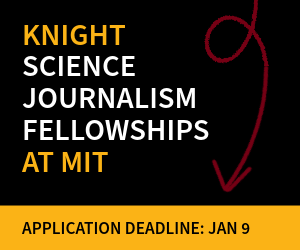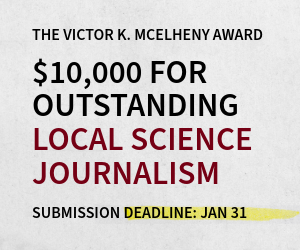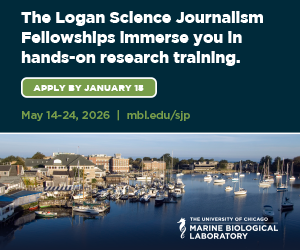The annual meeting of the National Association of Science Writers and the Council for the Advancement of Science Writing ends today in San Antonio, Texas, and our conference travel fellows have been filing reports on many of the panels and other sessions. You can read their coverage now on our past events page. Watch that page for more updates as they become available, and start making plans now for the World Conference of Science Journalists in San Francisco next October.
Science writing news
Most of us serve as the first and perhaps only fact-checker of our own work. “Learning how to fact-check can help writers become better reporters,” Brooke Borel asserts in The Chicago Guide to Fact-Checking. Fact-checking is reporting in reverse, she says. You need to fact-check everything, even the thing you just checked last week, and even things you think you know are true, she insists. You also need to identify what’s missing, and whether that undermines the accuracy of your work. Borel tells how to check facts from a variety of sources, including analogies, product claims, press releases, and maps and atlases. She also offers tips on keeping good records of your sources.
Reality is catching up with science fiction, Rod Pyle reports in Blueprint for a Battlestar: Serious Scientific Explanations Behind Sci-Fi’s Greatest Inventions. Consider force fields: a new type of armor plating applied to tanks, armored personnel carriers, and other kinds of vehicles, Pyle writes, can repel medium-sized munitions. Boeing recently patented a device that will use a high-energy ball of plasma to minimize injury to soldiers in a vehicle hit by an artillery shell, grenade, or Improvised Explosive Device. Pyle discusses the science behind 25 technologies, from Archimedes’ “heat ray” to tools employed in Star Wars and The Matrix. The book includes 75 detailed illustrations.
Star Trek marks its fiftieth anniversary of its debut this year. Celebrated both for its social commentary and futuristic science, the sci-fi series also prompted many of the researchers Mark Lasbury interviewed for The Realization of Star Trek Technologies to study science or pursue a specific research interest. “Current science advances show how forward-thinking and accurate many Star Trek technologies were,” Lasbury writes. In his book, he describes devices and techniques used in the show, the science the show’s writers drew upon to explain how these tools worked, and research that has mimicked these technologies, or aims to do so.
Why do some people succeed in life, while others struggle or fail? In March 1946, scientists recorded the birth of nearly every British baby born in a single week, launching what has become the world’s longest running major study of human development. In The Life Project: The Extraordinary Story of Our Ordinary Lives, Helen Pearson reports findings from this and additional studies that have tracked the lives of five generations of children, over 70,000 people throughout the British Isles. The studies richly answer the scientists’ initial questions, and illuminate interventions that can boost every child’s odds of success.
NASW has joined 40 journalism and open government organizations in sending an open letter to White House Press Secretary Josh Earnest in response to his recent New York Times letter to the editor touting the Obama administration's transparency.
In 1965, the Mariner spacecraft made the first successful flyby of Mars, taking 22 photos of the planet’s surface. In 1976, NASA landed twin Viking probes on Mars. Since 1996, a series of Martian rovers have enabled charting of ancient rivers, lakes, ocean beds, and valleys — a landscape that once perhaps could have supported life. Preparations for a manned mission to Mars are underway today. In Mars: Making Contact, Rod Pyle draws on oral histories and interviews, and includes a library of photos to tell the saga of human exploration of the red planet.
It's a mistake to think of taxes as a once-a-year affliction caused by the need to grapple with 1040 forms or to assemble records for a paid tax preparer. Federal and state tax planning needs to be a year-round concern on par with ongoing business and personal financial planning.
A blue man shows up in a hospital emergency department, then a red woman, then a yellow one, and soon large numbers of people display a kaleidoscope of colors. A rogue biologist has exposed them surreptitiously to a genetically engineered virus that takes over the body’s melanocytes, producing the unnatural hues. Worse, the colors serve as a marker of the scientist’s intent to employ bioweapons to create worldwide mayhem. The FBI’s on the case, and so is the CDC. In his sci-fi novel, The Rainbow Virus, Dennis Meredith provides a behind-the-scenes look at forensic and epidemiological detective work.
“A box jellyfish is little more than goo, yet it can kill a man in less than five minutes. A spider or a scorpion can be unceremoniously crushed under our feet, yet some of their venoms can take us out just as easily,” Christie Wilcox reports in Venomous: How Earth’s Deadliest Creatures Mastered Biochemistry. In this book, based on her PhD research, Wilcox introduces us to venom scientists around the world, telling what venoms do and how they work, and exploring their present and potential medical applications. She also includes stories of survivors of near-fatal venom exposure, individuals who — for highs or putative health benefits — self-inject venoms, and even venom-using murderers. And yes, Wilcox also recounts her own run-ins with venomous barbs and stingers.



